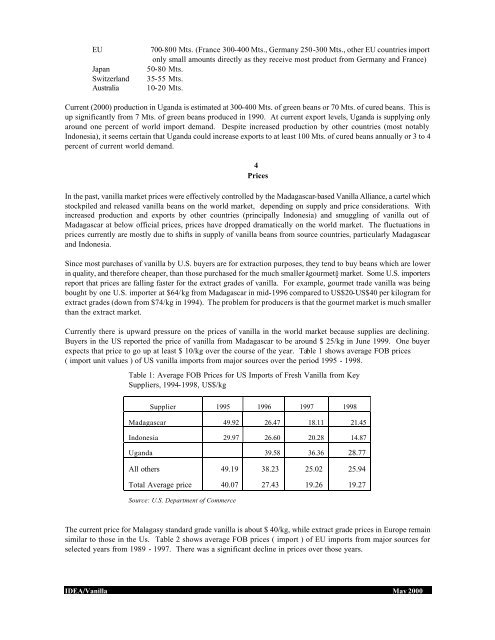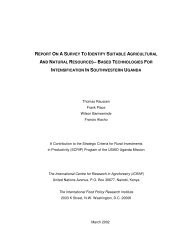ADC Commercialisation Bulletin #1 – Vanilla - Foodnet
ADC Commercialisation Bulletin #1 – Vanilla - Foodnet
ADC Commercialisation Bulletin #1 – Vanilla - Foodnet
You also want an ePaper? Increase the reach of your titles
YUMPU automatically turns print PDFs into web optimized ePapers that Google loves.
EU 700-800 Mts. (France 300-400 Mts., Germany 250-300 Mts., other EU countries import<br />
only small amounts directly as they receive most product from Germany and France)<br />
Japan 50-80 Mts.<br />
Switzerland 35-55 Mts.<br />
Australia 10-20 Mts.<br />
Current (2000) production in Uganda is estimated at 300-400 Mts. of green beans or 70 Mts. of cured beans. This is<br />
up significantly from 7 Mts. of green beans produced in 1990. At current export levels, Uganda is supplying only<br />
around one percent of world import demand. Despite increased production by other countries (most notably<br />
Indonesia), it seems certain that Uganda could increase exports to at least 100 Mts. of cured beans annually or 3 to 4<br />
percent of current world demand.<br />
4<br />
Prices<br />
In the past, vanilla market prices were effectively controlled by the Madagascar-based <strong>Vanilla</strong> Alliance, a cartel which<br />
stockpiled and released vanilla beans on the world market, depending on supply and price considerations. With<br />
increased production and exports by other countries (principally Indonesia) and smuggling of vanilla out of<br />
Madagascar at below official prices, prices have dropped dramatically on the world market. The fluctuations in<br />
prices currently are mostly due to shifts in supply of vanilla beans from source countries, particularly Madagascar<br />
and Indonesia.<br />
Since most purchases of vanilla by U.S. buyers are for extraction purposes, they tend to buy beans which are lower<br />
in quality, and therefore cheaper, than those purchased for the much smaller Agourmet@ market. Some U.S. importers<br />
report that prices are falling faster for the extract grades of vanilla. For example, gourmet trade vanilla was being<br />
bought by one U.S. importer at $64/kg from Madagascar in mid-1996 compared to US$20-US$40 per kilogram for<br />
extract grades (down from $74/kg in 1994). The problem for producers is that the gourmet market is much smaller<br />
than the extract market.<br />
Currently there is upward pressure on the prices of vanilla in the world market because supplies are declining.<br />
Buyers in the US reported the price of vanilla from Madagascar to be around $ 25/kg in June 1999. One buyer<br />
expects that price to go up at least $ 10/kg over the course of the year. Table 1 shows average FOB prices<br />
( import unit values ) of US vanilla imports from major sources over the period 1995 - 1998.<br />
Table 1: Average FOB Prices for US Imports of Fresh <strong>Vanilla</strong> from Key<br />
Suppliers, 1994-1998, US$/kg<br />
Supplier<br />
Madagascar<br />
Indonesia<br />
Uganda<br />
All others<br />
Total Average price<br />
1995<br />
49.92<br />
29.97<br />
49.19<br />
40.07<br />
Source: U.S. Department of Commerce<br />
The current price for Malagasy standard grade vanilla is about $ 40/kg, while extract grade prices in Europe remain<br />
similar to those in the Us. Table 2 shows average FOB prices ( import ) of EU imports from major sources for<br />
selected years from 1989 - 1997. There was a significant decline in prices over those years.<br />
IDEA/<strong>Vanilla</strong> May 2000<br />
1996<br />
26.47<br />
26.60<br />
39.58<br />
38.23<br />
27.43<br />
1997<br />
18.11<br />
20.28<br />
36.36<br />
25.02<br />
19.26<br />
1998<br />
21.45<br />
14.87<br />
28.77<br />
25.94<br />
19.27
















